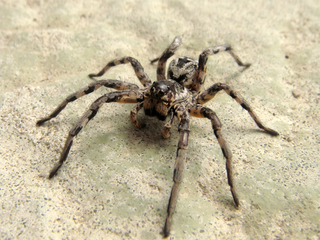
Wolf spiders are members of the family Lycosidae, named for their robust and agile hunting skills and excellent eyesight. They live mostly in solitude, hunt alone, and usually do not spin webs. Some are opportunistic hunters, pouncing upon prey as they find it or chasing it over short distances; others wait for passing prey in or near the mouth of a burrow. Wolf spiders resemble nursery web spiders, but wolf spiders carry their egg sacs by attaching them to their spinnerets, while the Pisauridae carry their egg sacs with their chelicerae and pedipalps. Two of the wolf spider's eight eyes are large and prominent; this distinguishes them from nursery web spiders, whose eyes are all of roughly equal size. This can also help distinguish them from the similar-looking grass spiders.

Lycosa tarantula is the species originally known as the tarantula, a name that nowadays in English commonly refers to spiders in another family entirely, the Theraphosidae. It now may be better called the tarantula wolf spider, being in the wolf spider family, the Lycosidae. L. tarantula is a large species found in southern Europe, especially in the Apulia region of Italy and near the city of Taranto, from which it gets its name.

The Artoriinae are a subfamily of wolf spiders. The monophyly of the subfamily has been confirmed in a molecular phylogenetic study, although the relationships among the subfamilies was shown to be less certain.
Anomalosa is a genus of spiders in the family Lycosidae. It was first described in 1960 by Carl Friedrich Roewer. The type species is Anomalosa kochi.
Costacosa is a genus of spiders in the family Lycosidae. It was first described in 2013 by Framenau & Leung. As of 2017, it contains 2 species, both from western Australia.
Dolocosa is a genus of spiders in the family Lycosidae. It was first described in 1960 by Roewer. As of 2017, it contains only one species, Dolocosa dolosa, on the island of Saint Helena.
Evippomma is a genus of spiders in the family Lycosidae. It was first described in 1959 by Roewer. As of 2017, it contains 6 species.
Foveosa is a genus of spiders in the family Lycosidae. It was first described in 2007 by Russell-Smith, Alderweireldt & Jocqué. As of 2017, it contains 5 species from Africa.
Gnatholycosa is a genus of spiders in the family Lycosidae. It was first described in 1940 by Mello-Leitão. As of 2017, it contains only one species, Gnatholycosa spinipalpis, found in Argentina.
Loculla is a genus of spiders in the family Lycosidae. It was first described in 1910 by Simon. As of 2017, it contains 5 species.
Margonia is a genus of spiders in the family Lycosidae. It was first described in 1983 by Hippa & Lehtinen. As of 2017, it contains only one species, Margonia himalayensis, found in India.
Megarctosa is a genus of spiders in the family Lycosidae. It was first described in 1948 by Caporiacco. As of 2017, it contains 7 species.
Melocosa is a genus of spiders in the family Lycosidae. It was first described in 1937 by Gertsch. As of 2017, it contains 2 species.
Pardosella is a genus of spiders in the family Lycosidae. It was first described in 1939 by Caporiacco. As of 2017, it contains 5 species from Ethiopia and Tanzania.
Syroloma is a genus of spiders in the family Lycosidae. It was first described in 1900 by Simon. As of 2017, it contains two species from Hawaii.

Tetralycosa is a genus of Australian spiders in the family Lycosidae first described by Roewer in 1960, later revised by Framenau & Hudson to include thirteen species. Genetic studies show that these spiders all diverged from a common ancestor who likely wandered into the salty area and remained. They live exclusively in certain saline environments of Australia's interior, including coastal beaches, mound springs, clay pans, and salt lakes. There haven't been enough studies to establish a conservation status, but some species have only been found in solitary salt lakes, suggesting that the increase of mining, agriculture, recreational, and similar disturbances of these unique ecosystems may eventually lead to their extinction if not properly regulated.
Tricassa is a genus of spiders in the family Lycosidae. It was first described in 1910 by Simon. As of 2017, it contains 2 African species.
Melecosa is a genus of spiders in the family Lycosidae. Its lone species is found in Kazakhstan, Kyrgyzstan, and China.
Gulocosa is a genus of spiders in the family Lycosidae. It was first described in 2015 by Marusik, Omelko & Koponen. As of 2017, it contains only one species, the Russian species Gulocosa eskovi.

Lycosa aragogi is a species of the araneomorph spider family Lycosidae endemic to Kerman Province, Iran. The female holotype measured 26mm,, with two black and three white stripes of setae on its cephalothorax, black setae on its chelicerae, and scattered dots and patterns of black and white setae on its abdomen.




